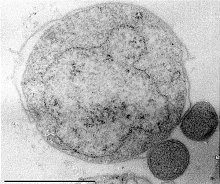Phylum of archaea From Wikipedia, the free encyclopedia
Nanoarchaeota (Greek, "dwarf or tiny ancient one") is a proposed phylum (Candidatus Nanoarchaeota) in the domain Archaea[1] that currently has only one representative, Nanoarchaeum equitans, which was discovered in a submarine hydrothermal vent and first described in 2002.[2]
| Nanoarchaeota | |
|---|---|
 | |
| Nanoarcheotum Nanopusillus acidilobi attached to Acidilobus. | |
| Scientific classification | |
| Domain: | Archaea |
| Superphylum: | DPANN |
| Phylum: | Nanoarchaeota |
| Class: | Nanobdellia Kato et al. 2022 |
| Order | |
| |
| Synonyms | |
| |
Members of the Nanoarchaeota are associated with different host organisms and environmental conditions.[3] Despite small size, a reduced genome and limited respiration, members of the Nanoarchaeota have unusual metabolic features. For example, N. equitans has a complex and highly developed intercellular communication system.[4]
The phylogeny of the Nanoarchaeota is anchored by its only cultured representative, Nanoarchaeum equitans, which clusters in a separate evolutionary group than other archaea,[5][6] which have recently been reclassified. Further analysis has shown that N. equitans diverged early on in the evolution of Archaea, as indicated by the 16S rRNA sequence. This suggests that they occupy a deeply branching position within this group.[7]
The currently accepted taxonomy is based on the List of Prokaryotic names with Standing in Nomenclature (LPSN)[8] and the National Center for Biotechnology Information (NCBI).[9]
| Phylogeny of Nanobdellota[10][11][12] | ||||||||||||||||||||||||||||||||||||||||||||||||||||||||||||||||||||||||||||||||||||||||||||||||||||||||||||||||||
|

Cells of N. equitans are spherical with a diameter of approximately 400 nm,[2] and have a very short and compact DNA sequence with the entire genome containing only 490,885 base pairs.[6] While they have the genetic code to carry out processing and repair, they cannot carry out certain biosynthetic and metabolic processes such as lipid, amino-acid, cofactor, or nucleotide synthesis.[6] Due to its limited machinery, it is an obligate parasite, the only one known in the Archaea.[6] Because of their unusual ss rRNA sequences, they are difficult to detect using standard polymerase chain reaction methods.[21] Cells of N. equitans contain a normal S-layer with sixfold symmetry with a 15 nm lattice constant.[21]
Small cells between 100 and 400 nm in diameter and highly streamlined genomes of 0.491-0.606 Mbp characterize nanoarchaeotes.[22] The genomes of described nanoarchaeotes demonstrate different degrees of reduction, which is compatible with a host dependent lifestyle.[23] Certain nanaoarchaeotes still have genes for the CRISPR-Cas systems, archaeal flagella, and the gluconeogenesis pathway.[24]
Nanoarchaeotes are obligate symbionts that grow attached to an archaeal host known as Ignicoccus.[25] Both terrestrial hot springs and underwater hydrothermal vents have yielded isolates in the genus Nanoarchaeum .[26] However, there is evidence that nanoarcheotes reside in a variety of habitats outside of marine thermal vents.[3] Genetic evidence for members of the Nanoarchaeota has been discovered to be pervasive in terrestrial hot springs and mesophilic hypersaline habitats using primers created based on the sequence of the 16S rRNA gene of Nanoarchaeum equitans.[3] In addition, the discovery of ribosomal sequences in photic-zone water samples taken distant from hydrothermal vents raises the possibility that Nanoarchaeota are an ubiquitous and diversified group of Archaea that can live in habitats with a variety of temperatures and geochemical settings.[3]
Although much of the metabolism of members of the Nanoarchaeota is unknown, its host is an autotroph that grows on elemental sulphur as an electron acceptor and H2 as an electron donor.[26] The majority of recognized metabolic processes, such as the creation of monomers like amino acids, nucleotides, and coenzymes, lack recognizable genes in this organism.[26]
Seamless Wikipedia browsing. On steroids.